They say well prepared is half done. And prepare we did for this trip. After all, we were going to a place where the slightest mistake could kill us. The roads would be some of the world’s most dangerous. We would be walking in knee deep snow or along precarious ledges. All of this when daytime temperatures would be below freezing, and at night they could drop far past -20ºC.
Winter snow closes the Rohtang and Kunzum passes, leaving the only access into Spiti via the Hindustan – Tibet Road, running via Simla, Rampur, Recong Peo and Nako. The road has been billed by its keepers, the Border Roads Organization as the ‘Most Treacherous Road in the World.’ While large parts of it today are wide, smooth tarmac – the greatest danger is from falling rocks and landslides. Having experienced shooting stones and massive landslides on previous visits, there was no way we were going to take the moniker lightly.

By the time we had reached Nako, at an altitude of 3625m – the temperature had already dropped below zero. Later that night, the car’s thermometer recorded a low of -12º C. And at these altitudes and temperatures, starting a diesel engine in the morning can be a nightmare. Having anticipated that, we dumped a bottle of anti-freeze into the fuel tank and got up once or twice in the night to run the engine for a few minutes to keep it warm.
Not only was the village freezing, our accommodation had no heating or functional plumbing. It took an eon to get the blankets warm, and all our will power to manage a dump in the open. But the hardships were worth it, for the most spectacular sunrise broke over the mountains the next morning.
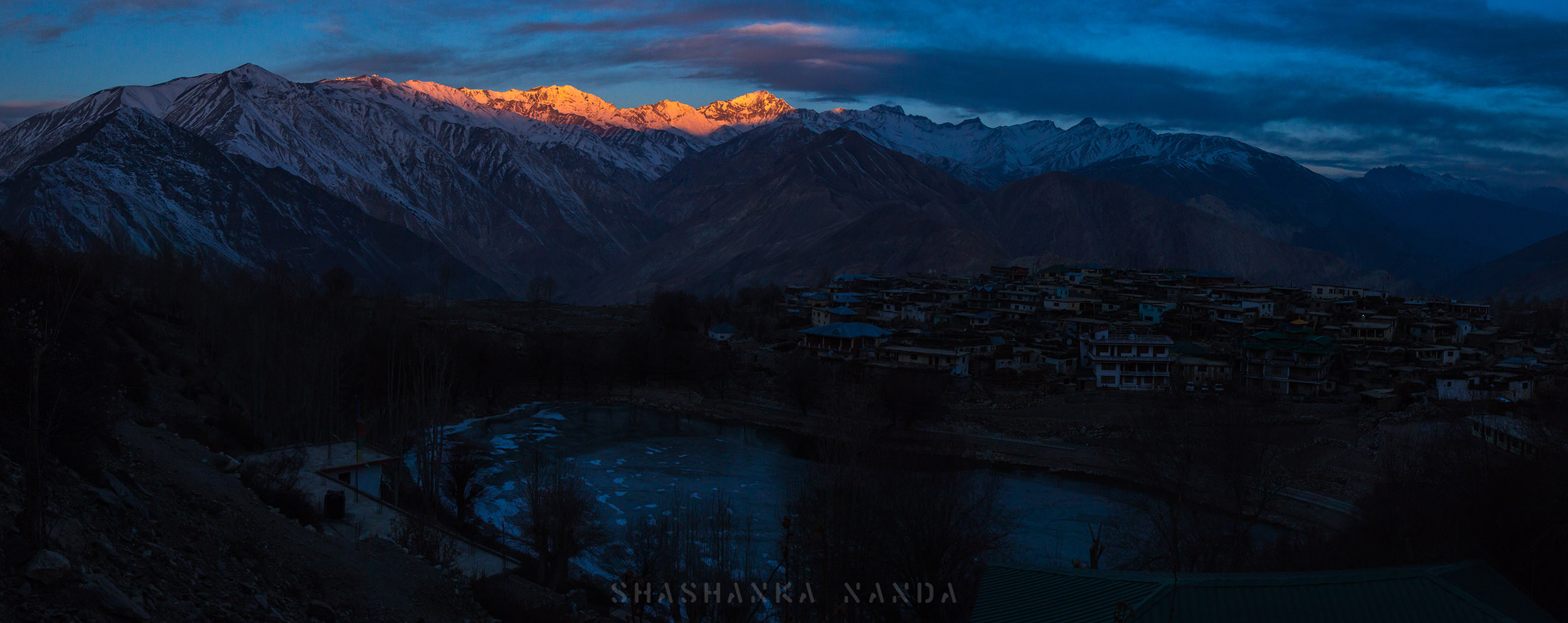
As the crisp air burnt our nostrils, the sight of the sun’s first rays bathing the mountains in an orange glow, made us forget the hardships of the previous night and we were ready to hit the road again.
The stretch from Nako to Chango and onward to Sumdo, where we officially enter Lahaul and Spiti District, has been the biggest challenge for road builders in the region. The Malling Nullah, past the eponymous village has devastated the road for years. Each summer, it brings down enormous quantities of boulders and landslides, blocking the road – sometimes for weeks at an end. And for that very reason, the older road alignment via the village of Yangthang was abandoned long ago.
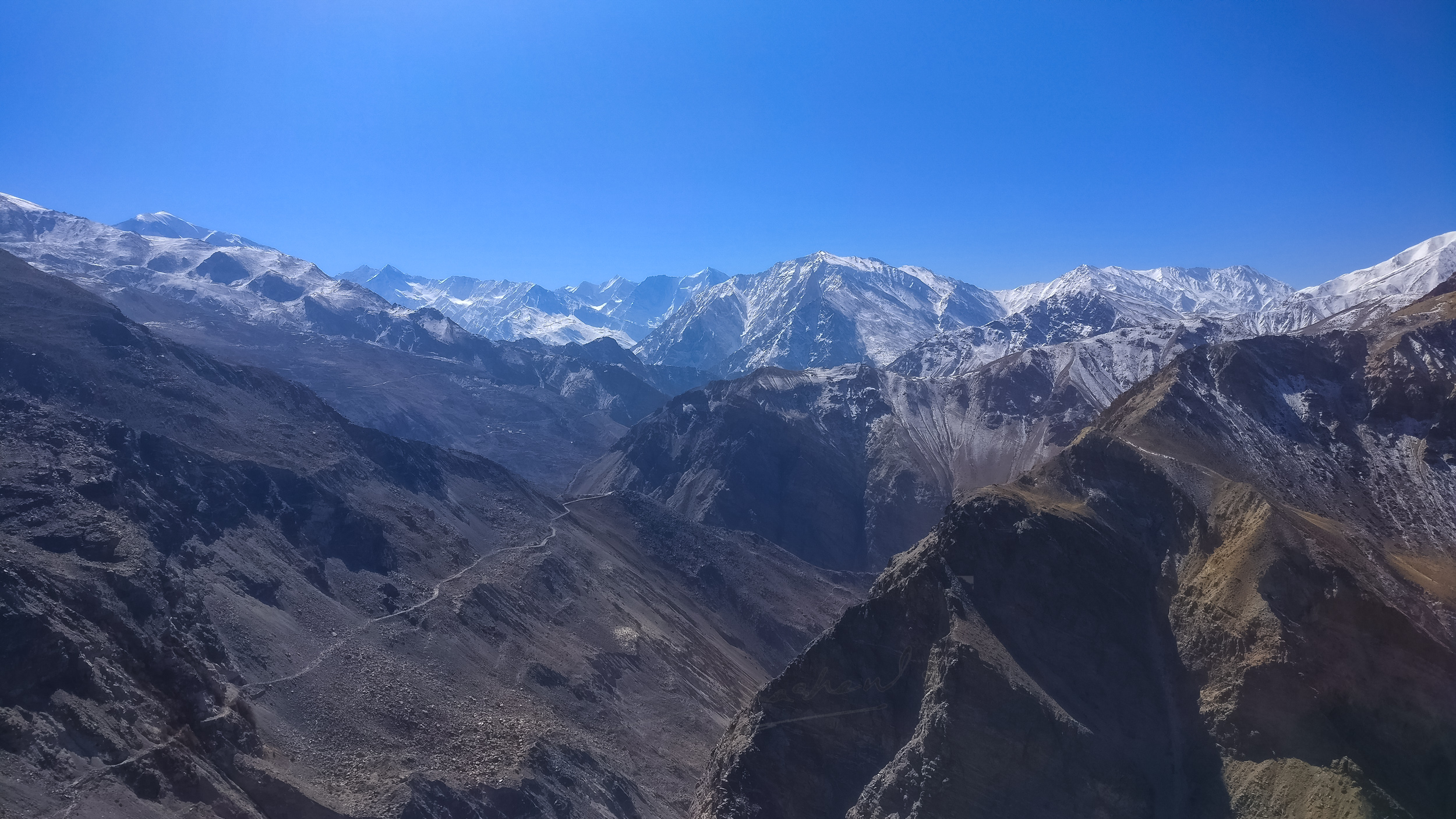
After making clearing the security checkpoint at Sumdo, we took a short detour to the village of Geyu (alt. Gue), nestled in a valley not far from the border with Tibet. The village is home to the mummified body of Sangha Tenzin, a Buddhist Monk who said to have fasted to death to rid the village of evil spirits. The slow process of starvation purportedly rid the body of fats and other elements that would have putrefied the body. And the cold, dry climate preserved it over hundreds of years. Today, the mummy is housed in a temple above the village and locals revere the monk who gave up his life for the village.

Sightseeing over, it was time to get down to business and make the final push to Kaza – the headquarters of Spiti. Given the improved road conditions, it is now possible to make run from Delhi to Kaza in two days. But we wanted to get accustomed to altitude gradually, for one does not take Acute Mountain Sickness (AMS) lightly. AMS can lead to shortness of breath, dizzy spells and headaches – and in extreme cases even a horrible death caused by pulmonary edema.
In winter, Kaza had ground to a halt. The market, mostly run by traders from the lower hills was shut. Only 2-3 shops selling essential items were open. And that too because the snowfall this year had been scanty and the roads were largely open. Locals normally stock up rations for 3 months. Fresh vegetables in winter are at a premium – potatoes forming bulk of the diet. We were however, fully prepared – carrying our rations of heat and eat ready meals, energy bars, chocolates and dry fruits, along with a portable stove to heat water.
On day 4, we drove up to the village of Kibber nestled at an altitude of 4270m. Kibber is the base for snow leopard expeditions in the region, and also the start point for the Parang La Pass trek, which connects Spiti with Ladakh. We would spend the next week as guests at the KaNamo Homestay, sharing space and meals with a local family. The bitter cold and snow makes it impossible to carry out commerce or agriculture – hence the locals just hunker down and wait the winter out. Income from tourism is perhaps the only inflow, as a result of which many homes in Spiti offer homestay services for visitors. And what better way can there be to understand local culture, customs and cuisine.
Our accommodation was a large room, heated centrally by a stove that was constantly on flame throughout our stay. Traditional Spitian houses are made of mud, with the roof insulated with dry grass. The stove and the construction ensure that indoors the temperature is 10-15ºC warmer than outside. Modern concrete buildings, like the we stayed in Nako can never achieve that.
We also met up with Dorje from the nearby village of Chicham. Dorje and his team would be our trackers and guides for the next week – helping us locate the elusive Ghost Cat of the Himalayas. We spent the evening discussing the possible impact of the scant snow on local lives in the coming summer, and the chances of spotting our elusive quarry. The discussion to say the least, was grim.
Paulo Coelho once wrote “And, when you want something, all the universe conspires in helping you to achieve it.” His words rang true as we peered outside our windows the next morning. Overnight it had started to snow, and a blizzard was still going strong. Reports of a male snow leopard in the area from a few days ago had come, and we were determined to get out, despite the weather. Hefting our gear, we set out towards a nearby gorge where ibex had been seen. It would make a good starting point, or so it seemed. Having located the ibex, we set up our cameras even as snow fell. It was an amazing sight to see them scamper across vertical cliffs like it was playground. And we marvelled at their tenacity – to live in this harsh environment and still manage to find food through the winter.
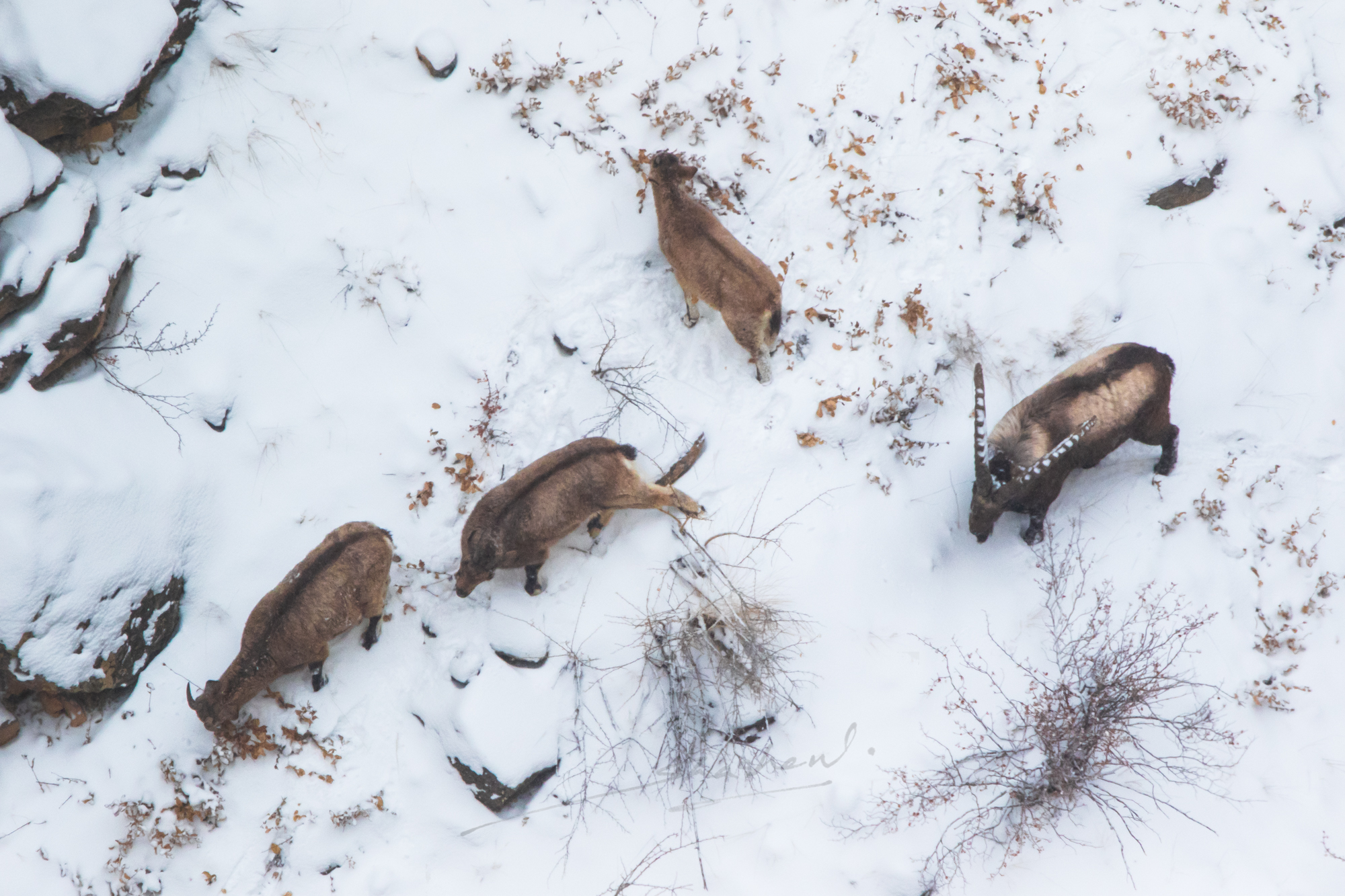
However, the blizzard got too strong and we had to beat a hasty retreat. By next day, having spent nearly 36 hours hemmed indoors, we grew restless. Weather be damned, we had to be out. So we trekked down to a gorge, where some ibex had been spotted by our guides earlier in the morning. For there are only two ways to find a snow leopard – follow herds of prey like bharal and ibex and look for signs of a leopard. Or follow tracks in snow, if you chance upon any. The fresh snow and presence of ibex was our best bet.
As we were photographing the herd on a cliff, Dorje our guide had his eyes on the other side of the valley. Sudden movement, and the sound of barking dogs from the village side alerted us. We hurriedly packed and started following the commotion. An hour’s walk through snow brought us to another gorge. Another pair of local guides were already there, and they were pointing down.
There, in a crevice with the carcass of a sheep, was the snow leopard.
 We learnt later that feral dogs had managed to separate a villager’s sheep from the flock and driven it towards the gorge. To their bad luck, the snow leopard pounced on it first and claimed it for its own. That explained the barking dogs. Feral dogs are becoming a problem in the mountains, as much in the city. With no control, populations have boomed and they are now competing with wild animals for prey, and even turning on livestock.
We learnt later that feral dogs had managed to separate a villager’s sheep from the flock and driven it towards the gorge. To their bad luck, the snow leopard pounced on it first and claimed it for its own. That explained the barking dogs. Feral dogs are becoming a problem in the mountains, as much in the city. With no control, populations have boomed and they are now competing with wild animals for prey, and even turning on livestock.
But the bigger problem was staring us in the face – not only was the snow leopard sitting on a kill. It was also sitting atop a pile of plastic trash that had flown into the gorge with water and ice. The entire nullah was replete with plastic bags, sacks and bottles which had been carelessly discarded by locals and tourists. The district has one of the highest per capita income in the country. And better access in recent years means tourist influx has grown as well. Without any means of recycling or managing waste – most of it is finding its way in rivers and other water bodies. The sight was incredulous – we were looking at one of the world’s most elusive animals, but our waste had found it first.
With a tinge of sadness, we headed back to base. The next morning – the male was still on his kill and was unlikely to move till it had finished. And by then word had spread and hordes of photographers had descended on the site. So we left him there and planned our next move. Reports of a female and young cubs in a nearby valley had reached us, so we decided to go after them. So early next morning, we set off on a longish climb to the ridge to the north of the village. We had climbed to nearly 5000m above sea level and cresting the ridge, we found signs of our quarry.
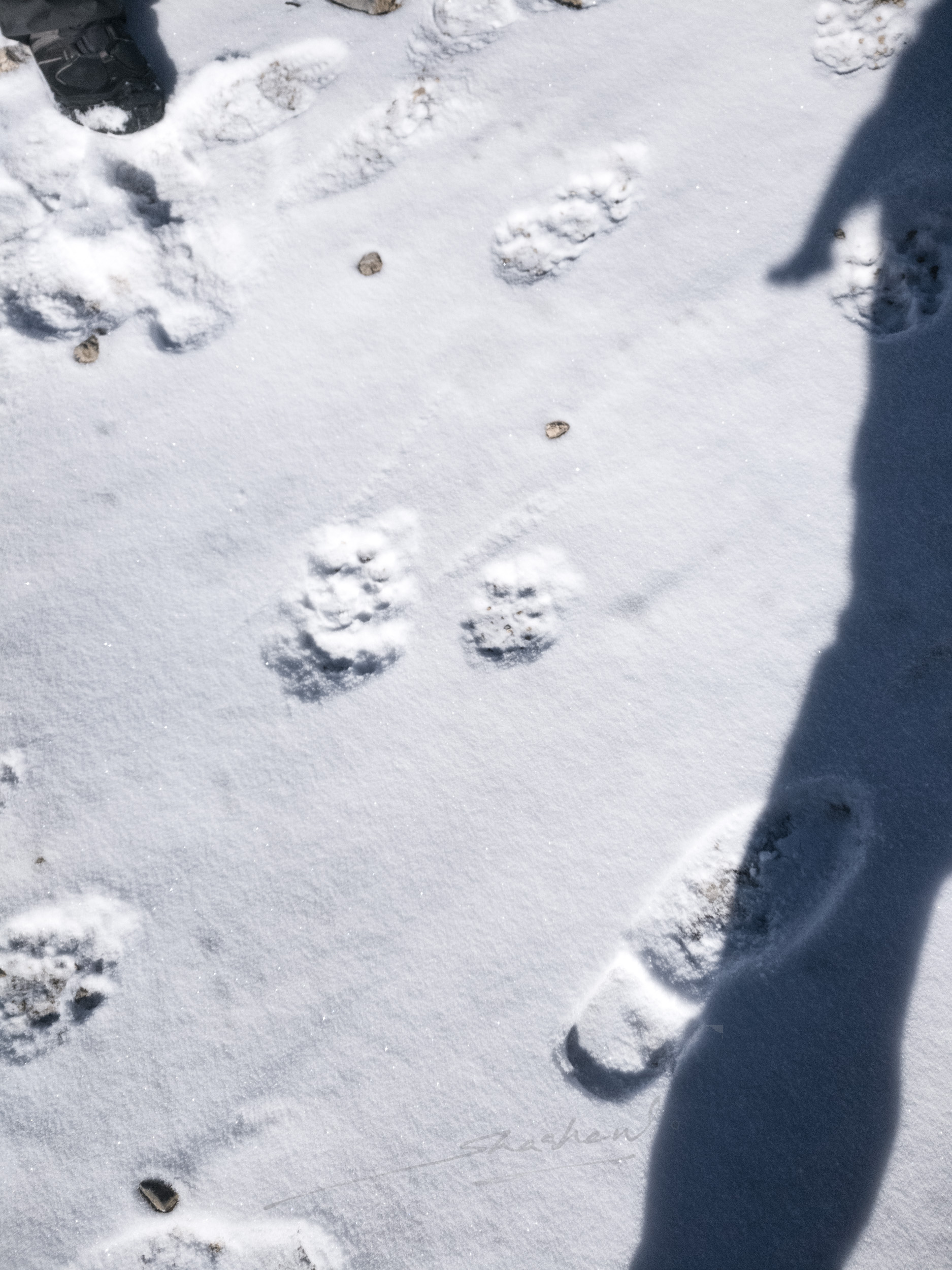
Fresh pugmarks – from the previous night. Just that the mother and cubs had gone downhill. That set us off on a merry chase. For the next four hours we followed their footprints across steep slopes, open meadows and down deep gorges until we could see them no more. We were tired, hot and sweaty – even when the ambient temperature was -6º C. Just when it seemed that the ghost cat had done its vanishing act once again, Dorje’s beaming face appeared from the gorge. The family had been located.
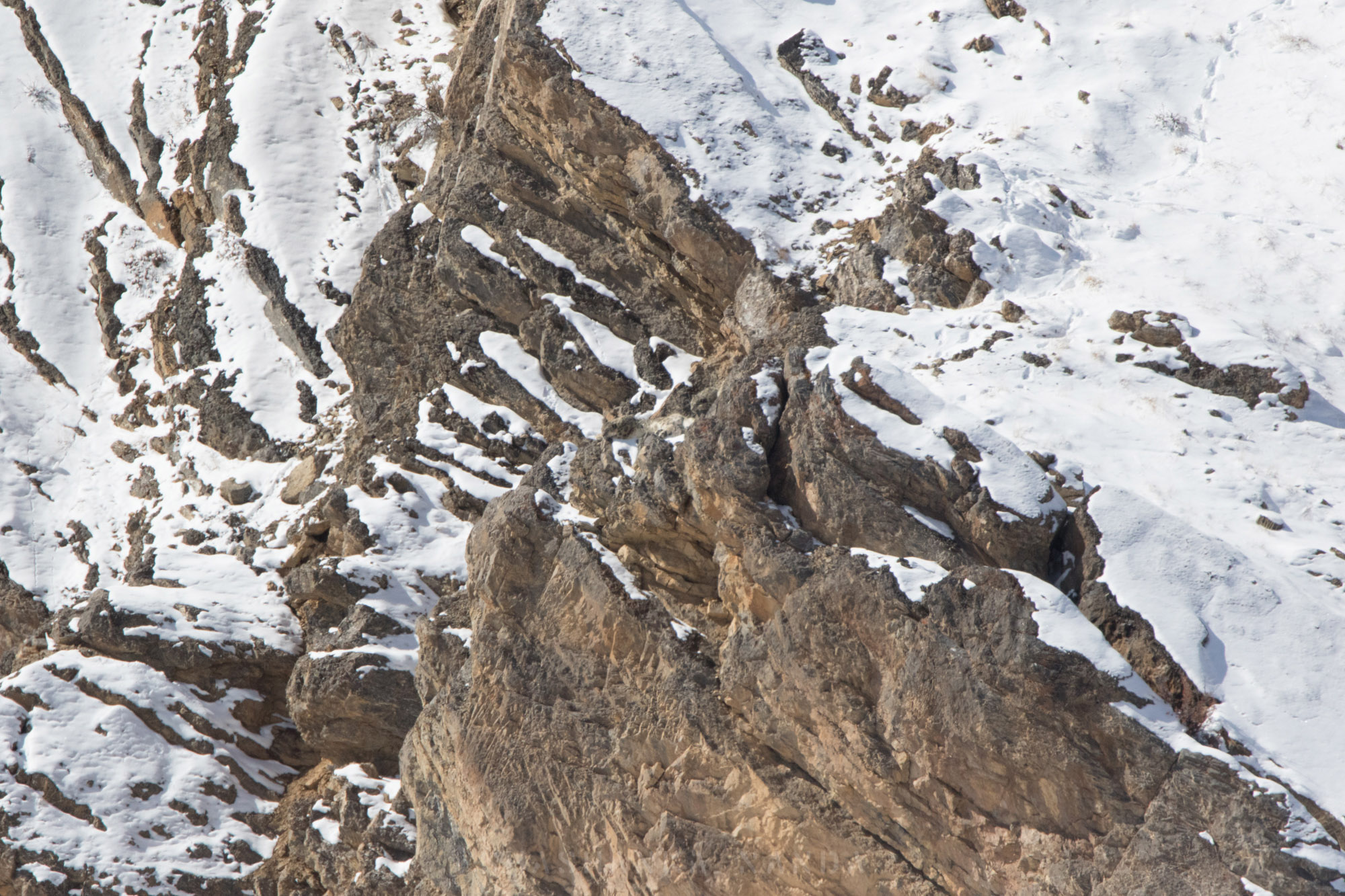
Another brisk walk later, we were on a steep slope overlooking the gorge. Dorje and Tashi were excitedly pointing towards a rock face on the other side. But we could barely discern anything – even with the help of binoculars or through the 500mm lens with a teleconverter boosting it to 700mm. We kept looking and looking when a tail flicked moved. And we realized we were looking straight at them all along, but their brilliant camouflage had hidden them in plain sight.
For the next few hours we watched the mother and cubs bask in the sun, play on the cliffside or just take naps. And just as the sun dipped, the mood changed. We had noticed the presence of an ibex herd on the next ridge. And that hadn’t escaped the mother either. She left the cubs under a ledge and stalked all the way across the mountain. Under cover of rock and bush, she inched her way towards the Ibex. An hour later, she had reached a little overhang and settled in there. She was going to play the waiting game – letting the Ibex come to her, than waste effort in chasing them. Seeing the mother gone, the cubs too retreated for the safety of their den.
What happened that night, we would never know. But the mother and cubs disappeared for the next four days. Absolutely no sign of them. The male too had finished its kill and vanished. For the next few days we searched high and low in the nearby valleys and ridges, but to no avail. The Ghost Cats had lived up to their name.
Leaving you with a few more images from the trip
This trip would not have been possible without Amisha and Bharath. Thanks for putting up with me and pushing me this far. And a big thank you to Tsering Bodh of Sakya Abode in Kaza as well. He makes Spiti feel like home.
To Dorje, Tashi and team – and the folks at KaNamo Home Stay, Tuthop and family in Kaza – thank you for sharing your world with us. It was an honour.

Lovely reading , felt I was there, beautiful pictures- best of luck for your next trip
Thank You aunty 🙂
Super stuff. Lucky fellow.
Shashank, do the locals have names for the Snow Leopards?
Thanks 🙂
No – the locals haven’t given them any individual names.